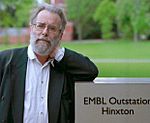Michael Ashburner facts for kids
Quick facts for kids
Michael Ashburner
FRS MAE
|
|
|---|---|

Michael Ashburner
|
|
| Born | 23 May 1942 |
| Died | 7 July 2023 (aged 81) |
| Nationality | British |
| Education | High Wycombe Grammar School |
| Alma mater | University of Cambridge (BA, PhD) |
| Known for |
|
| Spouse(s) |
Francesca Ryan
(m. 1963) |
| Awards |
|
| Scientific career | |
| Fields |
|
| Institutions |
|
| Thesis | Studies on puffing in the salivary gland chromosomes of Drosophila (1968) |
| Doctoral advisor | Alan Henderson |
| Influences | Bruce Alberts |
Michael Ashburner (born May 23, 1942 – died July 7, 2023) was a British biologist. He was a professor of genetics at the University of Cambridge. He also helped start and lead the European Bioinformatics Institute (EBI). This institute is a major center for using computers in biology. He was also a Fellow of Churchill College, Cambridge.
Contents
Early Life and Education
Michael Ashburner was born in Brighton, England. He went to High Wycombe Royal Grammar School from 1953 to 1960. He then studied at Churchill College, Cambridge. He earned his first degree in Natural Sciences in 1964. In 1968, he completed his PhD in Genetics. His PhD research looked at "puffing" in fruit fly chromosomes. He received a higher degree, a Doctor of Science, in 1978.
Studying Fruit Flies and Genes
Most of Michael Ashburner's research focused on the fruit fly, known scientifically as Drosophila melanogaster. Fruit flies are often used in science because they are easy to study. They help scientists understand how genes work.
Early Discoveries in Genetics
Ashburner's work started before many modern DNA techniques existed. He studied patterns called "puffing" in fruit fly chromosomes. Chromosomes are structures inside cells that contain genes. These "puffs" are places where genes are very active. He found that a hormone called ecdysone caused a chain reaction of genetic controls. This happened during the fruit fly's development after it was a larva. His 1974 model became a key idea for how genes are controlled in complex animals. He worked with many other scientists. He also guided many PhD students and researchers.
Mapping the Fruit Fly Genome
Michael Ashburner was part of a team that mapped the entire set of genes, or genome, of the Drosophila melanogaster fruit fly. This was a huge project. His memories of this work are in a book called "Won for All: How the Drosophila Genome Was Sequenced". His lab spent a long time studying a specific gene area called Adh. This work was very important for checking how scientists were mapping genes on a large scale. His research received funding from major UK science councils.
Computers and Biology
Ashburner was one of the first scientists to use computers in biology. He helped create FlyBase, a large database of information about fruit flies. He also helped develop Open Biomedical Ontologies. These are like organized dictionaries that let computers understand biological information. Two important examples are the Gene Ontology and ChEBI. He was also key in setting up the European Bioinformatics Institute (EBI). He was its first co-head.
Sharing Science with Everyone
Michael Ashburner strongly believed that scientific information should be free and available to everyone. When the fruit fly genome was mapped, he made sure the information was made public. He also argued that the human genome map should be freely available. He spoke out against making genetic information private.
He was one of the first to sign a letter in 2001 asking for a central place where all scientific papers could be stored and accessed for free. He became a strong supporter of Open Access publishing. This means making research papers available online without cost. He even gave evidence to the UK Parliament to support this idea. He also served on the first advisory board for UK PubMed Central. This was a website that mirrored a large collection of free biological research papers.
Awards and Recognition
Michael Ashburner received many awards for his important work. In 1993, he became an honorary member of the American Academy of Arts and Sciences. He received the Gregor Mendel Medal in 1998. In 1999, he got the first George W. Beadle Award. He also received honorary doctorates from the University of Crete in 2002 and the University of Edinburgh in 2003.
In 2005, he received the Genetics Society Medal. In 2006, he was given the Franklin Award for his work in bioinformatics. In 1990, he was elected a Fellow of the Royal Society (FRS). This is a very high honor for scientists in the UK. His election recognized his wide-ranging research on fruit flies. It noted his work on gene expression and how genes respond to different signals. He was also recognized for his detailed studies of specific chromosome regions. He also made important contributions to understanding how new species evolve within the D. melanogaster group. He became a Member of the Academia Europaea (MAE) in 1989.
Personal Life
Michael Ashburner was married to Francesca Ryan. They had three children: a son named Geoffrey and two daughters, Rebecca and Isabel. He passed away on July 7, 2023, at the age of 81.

